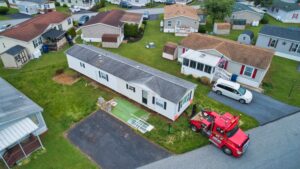The Environmental Benefits of Modular Buildings
Modern methods of construction are a key part of the UK’s plan to reach net zero by 2050. The built environment is responsible for 25%-30% of the country’s greenhouse gas emissions, with MPs warning that our approach to construction must change if we are to hit environmental targets. MMC is therefore concentrated on finding more sustainable ways to supply the buildings we need.
Modular buildings are a key part of this revolutionised approach to construction. These structures are made up of separate components created in one setting that can be quickly assembled on-site. Discover the many environmental benefits of modular buildings compared to their traditional counterparts.
Factory construction
First and foremost, modular buildings are constructed in factory conditions. Creating the components in these conditions, rather than on-site, allows for total control of the process. This in turn enables higher standards of efficiency to be met and ensures that there is less waste during construction.
Cleaner on-site operations
As the bulk of construction happens in a factory setting, modular buildings mean cleaner on-site operations. Less construction in the open air drastically reduces dust and noise pollution. Additionally, all of the building components can be transported in one go, dramatically reducing transport-related carbon emissions.
On-site operations can be further improved by utilising temporary modular building hire for offices, storage space, and staff accommodation. These structures can be built to satisfy a wide range of requirements and are easily dismantled at the end of the project.
Greener building materials
Another environmental benefit of modular buildings is that they are usually constructed from greener building materials than traditional structures. Common conventional materials like concrete and brick release CO2 into the atmosphere when they are produced and are hard to recycle. Greener alternatives used in modular building construction include bamboo, reclaimed wood, and recycled steel.
Higher energy efficiency
As well as requiring less energy to produce, modular buildings are made to use less energy too. Effective insulation means that buildings are quickly heated and stay warm for longer, while a range of energy-saving features such as climate control and automatic LED lighting further helps to keep energy usage low. Many traditional buildings are in need of retrofitting due to their poor energy efficiency, and this is a significant factor in current levels of UK carbon emissions.
Easily repurposed & recycled
The driving force behind traditional construction has often been cost. Unsustainable materials like concrete were favoured as they were cheap to produce, but have proved to be problematic in later years with UK public buildings feared to be at risk of collapse and many structures in need of repair. Modular buildings are designed to be easily repurposed and recycled but are also highly durable. This makes modular construction a ‘best of both worlds’ option.
